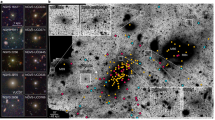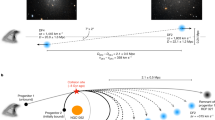Abstract
Dwarf satellite galaxies are thought to be the remnants of the population of primordial structures that coalesced to form giant galaxies like the Milky Way1. It has previously been suspected2 that dwarf galaxies may not be isotropically distributed around our Galaxy, because several are correlated with streams of H i emission, and may form coplanar groups3. These suspicions are supported by recent analyses4,5,6,7. It has been claimed7 that the apparently planar distribution of satellites is not predicted within standard cosmology8, and cannot simply represent a memory of past coherent accretion. However, other studies dispute this conclusion9,10,11. Here we report the existence of a planar subgroup of satellites in the Andromeda galaxy (M 31), comprising about half of the population. The structure is at least 400 kiloparsecs in diameter, but also extremely thin, with a perpendicular scatter of less than 14.1 kiloparsecs. Radial velocity measurements12,13,14,15 reveal that the satellites in this structure have the same sense of rotation about their host. This shows conclusively that substantial numbers of dwarf satellite galaxies share the same dynamical orbital properties and direction of angular momentum. Intriguingly, the plane we identify is approximately aligned with the pole of the Milky Way’s disk and with the vector between the Milky Way and Andromeda.
This is a preview of subscription content, access via your institution
Access options
Subscribe to this journal
Receive 51 print issues and online access
$199.00 per year
only $3.90 per issue
Buy this article
- Purchase on Springer Link
- Instant access to full article PDF
Prices may be subject to local taxes which are calculated during checkout



Similar content being viewed by others
References
Klypin, A., Kravtsov, A. V., Valenzuela, O. & Prada, F. Where are the missing galactic satellites? Astrophys. J. 522, 82–92 (1999)
Lynden-Bell, D. Dwarf galaxies and globular clusters in high velocity hydrogen streams. Mon. Not. R. Astron. Soc. 174, 695–710 (1976)
Lynden-Bell, D. & Lynden-Bell, R. M. Ghostly streams from the formation of the Galaxy’s halo. Mon. Not. R. Astron. Soc. 275, 429–442 (1995)
Metz, M., Kroupa, P. & Jerjen, H. The spatial distribution of the Milky Way and Andromeda satellite galaxies. Mon. Not. R. Astron. Soc. 374, 1125–1145 (2007)
Metz, M., Kroupa, P. & Libeskind, N. I. The orbital poles of Milky Way satellite galaxies: a rotationally supported disk of satellites. Astrophys. J. 680, 287–294 (2008)
Metz, M., Kroupa, P. & Jerjen, H. Discs of satellites: the new dwarf spheroidals. Mon. Not. R. Astron. Soc. 394, 2223–2228 (2009)
Pawlowski, M. S., Pflamm-Altenburg, J. & Kroupa, P. The VPOS: a vast polar structure of satellite galaxies, globular clusters and streams around the Milky Way. Mon. Not. R. Astron. Soc. 423, 1109–1126 (2012)
Komatsu, E. et al. Seven-year Wilkinson Microwave Anisotropy Probe (WMAP) observations: cosmological interpretation. Astrophys. J. 192 (Suppl.). 18 (2011)
Zentner, A. R., Kravtsov, A. V., Gnedin, O. Y. & Klypin, A. A. The anisotropic distribution of galactic satellites. Astrophys. J. 629, 219–232 (2005)
Lovell, M. R., Eke, V. R., Frenk, C. S. & Jenkins, A. The link between galactic satellite orbits and subhalo accretion. Mon. Not. R. Astron. Soc. 413, 3013–3021 (2011)
Wang, J., Frenk, C. S., Navarro, J. F., Gao, L. & Sawala, T. The missing massive satellites of the Milky Way. Mon. Not. R. Astron. Soc. 424, 2715–2721 (2012)
Collins, M. L. M. et al. The scatter about the ’Universal’ dwarf spheroidal mass profile: a kinematic study of the M31 satellites And V and And VI. Mon. Not. R. Astron. Soc. 417, 1170–1182 (2011)
Tollerud, E. J. et al. The SPLASH survey: spectroscopy of 15 M31 dwarf spheroidal satellite galaxies. Astrophys. J. 752, 45 (2012)
McConnachie, A. W. The observed properties of dwarf galaxies in and around the Local Group. Astron. J. 144, 4 (2012)
Collins, M. L. et al. The non-universal dSpH mass profile? A kinematic study of the Andromeda dwarf spheroidal system. Mon. Not. R. Astron. Soc (submitted)
McConnachie, A. W. et al. The remnants of galaxy formation from a panoramic survey of the region around M 31. Nature 461, 66–69 (2009)
Richardson, J. C. et al. PAndAS’ progeny: extending the M31 dwarf galaxy cabal. Astrophys. J. 732, 76 (2011)
Lee, M. G., Freedman, W. L. & Madore, B. F. The tip of the red giant branch as a distance indicator for resolved galaxies. Astrophys. J. 417, 553–559 (1993)
Conn, A. R. et al. A Bayesian approach to locating the red giant branch tip magnitude. I. Astrophys. J. 740, 69 (2011)
Conn, A. R. et al. A Bayesian approach to locating the red giant branch tip magnitude. II. Distances to the satellites of M31. Astrophys. J. 758, 11 (2012). 1209.4952
McConnachie, A. W. & Irwin, M. J. The satellite distribution of M31. Mon. Not. R. Astron. Soc. 365, 902–914 (2006)
Majewski, S. R. et al. Discovery of Andromeda XIV: a dwarf spheroidal dynamical rogue in the Local Group? Astrophys. J. Lett. 670, L9–L12 (2007)
Koch, A. & Grebel, E. K. The anisotropic distribution of M31 satellite galaxies: a polar great plane of early-type companions. Astron. J. 131, 1405–1415 (2006)
van der Marel, R. P. & Guhathakurta, P. M31 transverse velocity and local group mass from satellite kinematics. Astrophys. J. 678, 187–199 (2008)
Walker, M. G. Dark matter in the Milky Way’s dwarf spheroidal satellites. Preprint at http://arxiv.org/abs/1205.0311 (2012)
Barnes, D. G., Fluke, C. J., Bourke, P. D. & Parry, O. T. An advanced, three-dimensional plotting library for astronomy. Publ. Astron. Soc. Aust. 23, 82–93 (2006)
Acknowledgements
We thank the staff of the Canada-France-Hawaii Telescope for taking the PAndAS data, and for their continued support throughout the project. We thank one of our referees, B. Tully, for pointing out that IC 1613 could also be associated to the planar structure. R.A.I. and D.V.G. gratefully acknowledge support from the Agence Nationale de la Recherche though the grant POMMME, and would like to thank B. Famaey for discussions. G.F.L. thanks the Australian Research Council for support through his Future Fellowship and Discovery Project. This work is based on observations obtained with MegaPrime/MegaCam, a joint project of CFHT and CEA/DAPNIA, at the Canada–France–Hawaii Telescope, which is operated by the National Research Council (NRC) of Canada, the Institut National des Sciences de l’Univers of the Centre National de la Recherche Scientifique (CNRS) of France, and the University of Hawaii. Some of the data presented here were obtained at the W.M. Keck Observatory, which is operated as a scientific partnership among the California Institute of Technology, the University of California and the National Aeronautics and Space Administration. The Observatory was made possible by the generous financial support of the W.M. Keck Foundation.
Author information
Authors and Affiliations
Contributions
All authors assisted in the development and writing of the paper. In addition, the structural and kinematic properties of the dwarf population, and the significance of the Andromeda plane were determined by R.A.I., G.F.L. and A.R.C., based on distances determined by the same group (as part of the PhD research of A.R.C.). In addition, A.W.M. is the Principal Investigator of PAndAS; M.J.I. and R.A.I. led the data processing effort; R.A.I. was the Principal Investigator of an earlier CFHT MegaPrime/MegaCam survey, which PAndAS builds on (which included S.C.C., A.M.N.F., M.J.I., G.F.L., N.F.M. and A.W.M.). R.M.R. is Principal Investigator of the spectroscopic follow-up with the Keck Telescope. M.L.C. and S.C.C. led the analysis of the kinematic determination of the dwarf population, and N.F.M. led the detection of the dwarf population from PAndAS data. N.G.I. performed the initial analysis of the satellite kinematics.
Corresponding author
Ethics declarations
Competing interests
The authors declare no competing financial interests.
Supplementary information
Supplementary Information
This file contains Supplementary Text 1-2, Supplementary Figure 1 and a Supplementary Reference. (PDF 126 kb)
Rights and permissions
About this article
Cite this article
Ibata, R., Lewis, G., Conn, A. et al. A vast, thin plane of corotating dwarf galaxies orbiting the Andromeda galaxy. Nature 493, 62–65 (2013). https://doi.org/10.1038/nature11717
Received:
Accepted:
Published:
Issue Date:
DOI: https://doi.org/10.1038/nature11717
This article is cited by
-
A younger Universe implied by satellite pair correlations from SDSS observations of massive galaxy groups
Nature Astronomy (2024)
-
Planes of satellites no longer in tension with ΛCDM
Nature Astronomy (2023)
-
Baryonic solutions and challenges for cosmological models of dwarf galaxies
Nature Astronomy (2022)
-
Planes of satellites are not a problem for (just) ΛCDM
Nature Astronomy (2021)
-
It’s time for some plane speaking
Nature Astronomy (2021)
Comments
By submitting a comment you agree to abide by our Terms and Community Guidelines. If you find something abusive or that does not comply with our terms or guidelines please flag it as inappropriate.



